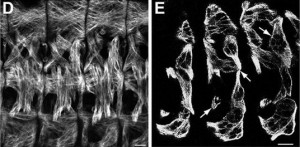Goalward-bound: why biological research is like football
Posted by Christele Gonneau, on 3 July 2014
The 2014 FIFA World Cup has mesmerised football fans all around the world over the past weeks, but besides just the fancy footwork on display, we’ve also seen some amazing athleticism. Many of the matches have taken place under scorching, highly humid conditions! Though this might not be foremost in our minds as marvel at the ball-mastery and cheer on our favorite teams, at the same time we are witnessing the marvel of muscle tissue too.
Muscle consists in organized patterns of muscle fibers that contain multiple nuclei. During development, these fibers are assembled from fusion of muscle cells. In the fruitfly Drosophila, founder cells fuse with multiple fusion-competent myoblasts (FCM) to form the muscle fiber. In a recent study published in Development, Ciglar and colleagues attempted to understand a bit more how different muscle cell fates (ie: founder cells and FCMs) are determined during development.
They showed that the proteins tramtrack69 (Ttk69) and lame duck (Lmd) were essential for the normal development of Drosophila muscles. Interestingly, they showed that the acquisition of FCM identity resulted from the combined actions of Ttk69 and lame duck: Ttk69 repressing the expression of founder cell genes whereas Lmd activating the expression of FCM genes.
On this picture you can observe (in white) the expression of β-3 tubulin, a marker of cell “skeleton”, in normal embryos (left picture) and in embryos in which Ttk69 has been deleted by genetic engineering (right picture). Since the deletion of Ttk69 leads to the formation of abnormal muscle fibers, the authors conclude that Ttk69 is mandatory for normal muscle development.
This study is a step toward the understanding of the complex machinery involved in muscle development. Robust understanding of what factors direct cell fates during development is key for stem cell biologists. As we try to direct stem cells towards a specific fate, we try to recapitulate development, and we base our experimental strategies on what we know from developmental biology. In this sense, biological research is like football: scoring a beautiful goal involves patience, hard work, and usually a long skillful build-up involving players with different expertise. And as we focus on the strikers that reach the scoring line, we must remember to admire the entire team!
Picture credit:
Ciglar, L., Girardot, C., Wilczy ski, B., Braun, M., & Furlong, E. (2014). Coordinated repression and activation of two transcriptional programs stabilizes cell fate during myogenesis Development, 141 (13), 2633-2643 DOI: 10.1242/dev.101956



 (1 votes)
(1 votes)